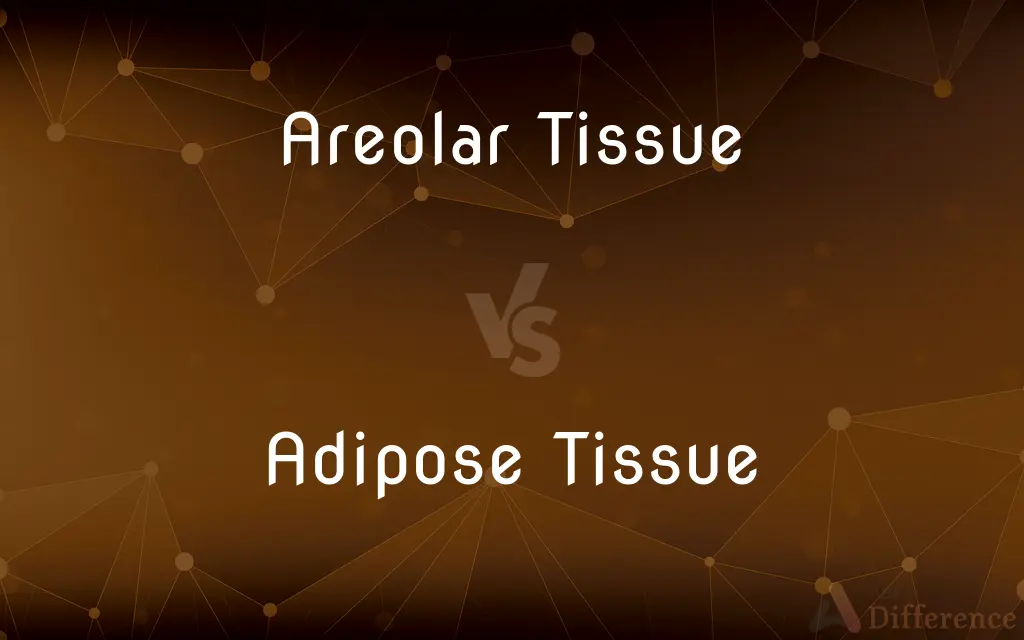Areolar Tissue vs. Adipose Tissue — What's the Difference?
Edited by Tayyaba Rehman — By Fiza Rafique — Published on December 4, 2023
Areolar tissue is a loose connective tissue that binds and supports body organs, while adipose tissue is a specialized tissue for fat storage, providing insulation and cushioning.

Difference Between Areolar Tissue and Adipose Tissue
Table of Contents
ADVERTISEMENT
Key Differences
Areolar tissue is a type of connective tissue that is found throughout the body, providing support and elasticity, whereas adipose tissue is specifically designed for the storage of energy in the form of fat.
Both areolar tissue and adipose tissue play vital roles in the human body; areolar tissue acts as the body's "packing material," supporting and binding different tissues, while adipose tissue serves as an energy reserve and insulation.
Areolar tissue is composed of cells, fibers, and a gel-like ground substance, making it highly versatile and flexible. In contrast, adipose tissue mainly contains fat cells known as adipocytes, which store large amounts of lipids.
Located in various parts, areolar tissue can be found between muscles and beneath the skin, playing a crucial role in providing elasticity and turgidity. Adipose tissue, on the other hand, accumulates in specific areas like the belly, thighs, and buttocks, offering protective padding.
While areolar tissue facilitates the exchange of nutrients and waste products between cells and blood, adipose tissue's primary function revolves around energy storage, thermoregulation, and protection.
ADVERTISEMENT
Comparison Chart
Primary Function
Support and bind organs
Energy storage and insulation
Cell Type
Contains fibroblasts, mast cells, macrophages, etc.
Mainly contains adipocytes
Location
Found throughout the body (e.g., beneath the skin)
Accumulates in specific areas like the belly, thighs, and buttocks
Composition
Cells, fibers, gel-like ground substance
Predominantly fat cells
Role in Metabolism
Facilitates nutrient and waste exchange
Energy reserve and thermoregulation
Compare with Definitions
Areolar Tissue
A type of loose connective tissue found throughout the body.
Areolar tissue can be found beneath the skin, providing elasticity and support.
Adipose Tissue
Essential for thermoregulation and energy storage.
On cold days, the body relies on adipose tissue for warmth.
Areolar Tissue
Facilitates nutrient and waste exchange.
The rich vascularization of areolar tissue aids in efficient nutrient exchange.
Adipose Tissue
Provides insulation and cushioning for organs.
Adipose tissue helps keep our internal organs protected and warm.
Areolar Tissue
Functions as a flexible support framework for organs.
The organs in our body rely on the supporting nature of areolar tissue.
Adipose Tissue
A specialized connective tissue that stores fat.
The body stores excess calories in the form of fat within adipose tissue.
Areolar Tissue
Often found between muscles, offering flexibility and turgidity.
The spaces between our muscles contain areolar tissue, which helps in movement and flexibility.
Adipose Tissue
Contains cells called adipocytes that store lipids.
The large cells in adipose tissue, known as adipocytes, are filled with lipids.
Areolar Tissue
Characterized by a variety of cell types and fibers.
Microscopic examination reveals the diverse composition of areolar tissue.
Adipose Tissue
Can be categorized as brown or white based on its function and appearance.
Brown adipose tissue burns energy, while white adipose tissue stores energy.
Common Curiosities
Can areolar tissue be found in the skin?
Yes, areolar tissue is located beneath the skin, offering support and elasticity.
What is the primary function of areolar tissue?
Areolar tissue binds and supports body organs, providing elasticity and flexibility.
What types of cells can be found in areolar tissue?
Areolar tissue contains a variety of cells, including fibroblasts, mast cells, and macrophages.
How is adipose tissue related to body fat?
Adipose tissue is the specialized tissue where the body stores fat, mainly in adipocytes.
Do both areolar and adipose tissue belong to connective tissues?
Yes, both areolar and adipose tissue are types of connective tissues with different specialized functions.
What is the difference between brown and white adipose tissue?
Brown adipose tissue burns energy and generates heat, while white adipose tissue mainly stores energy.
Can adipose tissue influence hormone production?
Yes, adipose tissue can produce certain hormones and play a role in endocrine functions.
Is it possible to reduce adipose tissue through exercise?
Yes, regular exercise can lead to the burning of stored fat in adipose tissue, reducing its volume.
Why is adipose tissue important for insulation?
Adipose tissue provides a layer of insulation, helping regulate body temperature.
How does adipose tissue contribute to energy storage?
Adipose tissue stores energy in the form of fat, which the body can utilize during periods of energy deficiency.
Does areolar tissue play a role in immune responses?
Yes, areolar tissue contains immune cells like mast cells and macrophages that contribute to immune reactions.
Is areolar tissue vascularized?
Yes, areolar tissue is richly vascularized, facilitating nutrient and waste exchange.
Can an excess of adipose tissue be harmful?
Excessive adipose tissue, particularly visceral fat around organs, can be associated with health risks like heart disease and diabetes.
How does areolar tissue aid in wound healing?
Areolar tissue's rich vascularization and flexibility support the repair and regeneration of tissues post-injury.
Why is areolar tissue considered a "loose" connective tissue?
Areolar tissue is termed "loose" due to its flexible, gel-like matrix and diverse cell composition.
Share Your Discovery

Previous Comparison
Electron Gain Enthalpy vs. Electronegativity
Next Comparison
RAPD vs. RFLPAuthor Spotlight
Written by
Fiza RafiqueFiza Rafique is a skilled content writer at AskDifference.com, where she meticulously refines and enhances written pieces. Drawing from her vast editorial expertise, Fiza ensures clarity, accuracy, and precision in every article. Passionate about language, she continually seeks to elevate the quality of content for readers worldwide.
Edited by
Tayyaba RehmanTayyaba Rehman is a distinguished writer, currently serving as a primary contributor to askdifference.com. As a researcher in semantics and etymology, Tayyaba's passion for the complexity of languages and their distinctions has found a perfect home on the platform. Tayyaba delves into the intricacies of language, distinguishing between commonly confused words and phrases, thereby providing clarity for readers worldwide.
















































